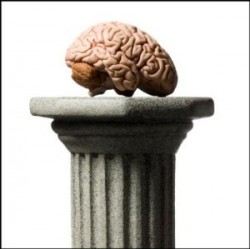Jul 15
20
How to Improve Productivity and Get Better Results by . . .
Putting the More Powerful Part of the Mind into a Position of Control!

It presents in popular science format research from psychology and behavioral economics on the adaptive unconscious.
I just finished Malcolm Gladwell’s 2007 book, Blink: The Power of Thinking Without Thinking; how I came into possession of Blink is stronger evidence for the power of the other-than-conscious parts of the minds of these human bodies we occupy than even the content of Gladwell’s book …which is very compelling! About three years ago I started doing a bit of research on the internet into the branch of science called neurobiology; which culminated in the writing of my latest “Brad Cullen” book, Integration of the Mind, ©SHS Publishing, Burnaby, BC, Canada – November 2014.
That study developed in me the thesis that the mind, contained in this body-bag I occupy, is comprised of each of the billions of cells scattered throughout the entire body; each of those cells having a neurotransmitter which is in constant communication with all the other cells, from the top of the head to the tips of the toes and which make up the entire nervous system and IS the mind.
The brain, according to much of the available neurobiological research, while an integral part of the whole, is more like a telephone switching station or the microprocessor of a computer and not the entirety of the mind as we’ve been led, until just recently, to believe.
The other-than-conscious parts of the mind, according to neurobiological research, are able to process information multiplied millions of times faster than the conscious part. This fact indicated to me, and the primary reason for writing Integration of the Mind, that I needed to find a way to involve the other-than-conscious parts of my mind in the kinds of things we’ve been led to believe are the sole responsibility of the cognitive or thinking “conscious” part of the mind.
During a telephone call with the CEO of the company, that published Integration of the Mind, he told me that the reason he felt this was such an important book and what so many people missed, he felt, was the concept of bringing the conscious and subconscious into a loving, cooperative relationship with each other.
Before elaborating a bit on exactly what I mean by such a relationship and the ways I’ve discovered to implement it, let’s go back to Gladwell’s book Blink and how I obtained it, because it will provide a perfect example of one of the advantages of having an active and cooperative partnership between the two parts of our minds.
I had about two dozen books cluttering my office which I decided to donate to the library within the clubhouse of our neighborhood. As I was placing them on the intake table, my attention was drawn to a title on a bright yellow dust jacket cover on the book shelves nearby. All of a sudden it was as though there was a spotlight focused on the shelf above the glaring yellow cover to, Blink: Thinking without thinking, I immediately knew I was supposed to take it.
I didn’t realize the reason until I brought it back to my office and couldn’t put it down …until I read it to the end, while scribbling several notes. Here’s the deal: Two days ago I very purposely told MEGA-me, the affectionate name I use for what I refer to as the internal supervisor of all the parts of the other-than-conscious parts of the mind of this body I occupy (and who is also a co-chairman and equal member of my imaginary mastermind group of advisors with whom I sit around a conference table for advice in making decisions), that I needed some reference material for a thesis growing in my consciousness.
As is becoming a habit, I trusted and fully expected MEGA-me to follow through …and Blink was the result; …and, it is doing the job perfectly! The thesis referenced just above, is that there are many things, such as obtaining Blink, that are far better left to the other-than-conscious and that I needed, as a purposeful intent, to take the conscious part out of the equation and to stop interfering with the automatic work of the other-than-conscious. As bizarre as this may be sounding to some of you, I urge you to stop judging and look at it from my perspective.
If you have any of the tendencies that I, just as millions of others have been trained to believe, that is, that the conscious part of the mind should be the captain of my ship of life and that all the other-than-conscious parts of the mind should be subordinate members of the crew –my rightly or wrongly interpretation of a strong contention of one of my favorite authors, Robert Anthony– then you may want to pay attention to the amazing discoveries a number of us are enjoying by allowing our imaginations and other-than-conscious parts to play a far bigger role in decision making and, again, to stop interfering with the process.
Now then some important stuff gleaned from Gladwell’s Blink: Thinking Without Thinking; boiled down into just four questions this best-selling author and his thirty-year experience with the New Yorker and the Washington Post as a top rated science and medical journalist posed and answered in his book: (1) Why are some people brilliant decision makers, while others are consistently inept? (2) Why do some people follow their instincts and win, while others end up stumbling into error? (3) How do our “brains”* really work-in the office, in the classroom, in the kitchen, and in the bedroom? (4) And why are the best decisions often those that are impossible to explain to others?
The answers Gladwell gives are brilliant and authoritative with some great neurobiological scientific data about the power of the “subconscious”* to back it up, BUT he, as does any top, experienced journalist tends to do is report, without a whole lot of useful suggestions as to how us common folks can engage the other-than-conscious parts of the mind to take over and get the conscious part to get out of the way when that is an appropriate avenue to get better results.
* “Brains” and “subconscious” are in quotes simply because these are both words that tend to reinforce our archaic programming forgetting that the subconscious is merely one of the labels of the many facets of the entirety of what I have chosen to call “other-than-conscious” as a catch-all rather than get into all the various subsets and each of their distinct purposes and “the mind” to get me out of the habit of thinking the brain is the entirety of the mind when it clearly is not.
In the intervening months since the publishing of Integration of the Mind the publisher, Mark Kennedy and I have been experimenting with the concept of engaging the conscious with the other-than-conscious in a loving, cooperative relationship between the two and with surprising breakthroughs for us both; and out of which came the decision to share some of what we’ve learned with two introductory YOU WITHOUT LIMITS free “Workshops” …please visit www.youwithoutlimits.life then scroll down to the articles – there’s no cost or obligation and if you do decide to get involved in a workshop it will be online and therefore in the privacy of your own home.



